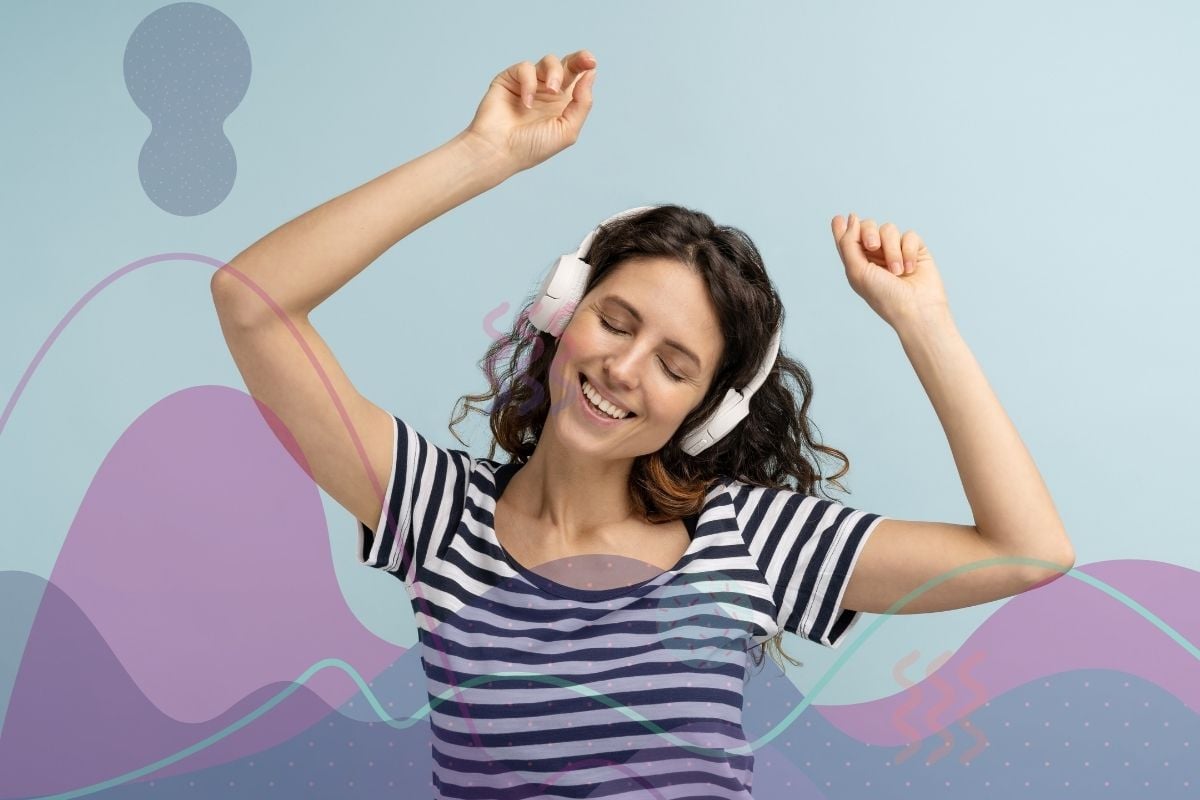Our guide on how to get epic bass in headphones, plus the eight best bass headphones you can go for.
| Name | Type | Frequency Range | Driver size | Price |
|---|---|---|---|---|
| 1MORE H1707 Best Overall | Closed-back | 20 Hz – 40 KHz | 40mm | BUY |
| Skullcandy Crusher Evo Strong Runner-Up | Closed-back | 20Hz - 20KHz | 40mm | BUY |
| Monoprice Modern Retro Best Budget | Closed-back | 15Hz - 25kHz | 50mm | BUY |
| Fostex TH-900 MK2 Best Premium | Closed-back | 5Hz - 40KHz | 50mm | BUY |
| Sony MDR-XB950B1 Best Absolute Bass Heads | Closed-back | 3Hz - 28KHz | 40mm | BUY |
| Audeze LCD-2 Classic Best Open-back | Open-back | 10Hz - 50kHz | 106 mm | BUY |
| SENNHEISER Momentum 3 Best Noise Cancelling | Closed-back | 6Hz - 22kHz | 42 mm | BUY |
| Jabra Elite Active 75t Best for Active Lifestyles | True Wireless Earbuds | 20Hz - 20KHz | 6mm | BUY |
How to Choose the Best Bass Headphones
There’s something undeniably satisfying in the rhythmic thump of a well-crafted bass line. But what happens when you want more and turning up the volume just isn’t enough? One option would be to adjust your equalizer settings. But if you aren’t familiar with or keen on that, the next best solution is to pick up a new pair of headphones with a “bass boost” or “extra bass” feature.
But before you do, it’s important to remember that different headphones come with their own unique sound quality. This means that bass quality between different headphones varies too.
As such, it’s important to go for headphones that’ll give you that extra oomph without ruining your listening experience. And the best way to do that is by understanding what features contribute to a good bass response in headphones.
In this article, we’ll tackle the factors that make up great-sounding bass and how to look for them in headphones. So, let’s get started!
What makes a great bass response?
In a very general sense, you can categorize bass as either punchy or boomy. Punchy bass has a tighter, sharper, and clearer quality that doesn’t bleed into other frequencies. And boomy bass is the opposite in that it sounds louder and a little less defined.
Several specs determine how the bass sounds on a pair of headphones. Here are the important ones to look out for:
Frequency range
The frequency range refers to audio frequencies (bass, midrange, treble) a pair of headphones are capable of producing. Standard headphones typically have a frequency range of 20Hz to 20kHz, which is also the range of what the human ear can hear. Bass frequencies, however, can go from 250 Hz to as low as 16Hz.
Though this is technically beyond the scope of what we can hear, these lower bass frequencies can still be felt and still have an impact on sound quality. As such, try going for headphones with a wider frequency range that expands beyond the usual 20Hz limit for nice, rich bass.
Drivers
Headphone drivers are those tiny speakers in your ear cups that emit sound. They range from 20mm to 50mm in size, with the larger ones capable of producing louder sounds. This is because these have larger diaphragms that produce more soundwaves.
Keep in mind, however, that driver size isn’t always synonymous with good bass. To illustrate, balanced armature (BA) drivers are extremely small and can’t reproduce deep bass. However, some that are specifically tuned for bass can produce decently low frequencies.
Headphones with larger drivers, like planar drivers, can typically produce better bass. But this doesn’t always translate to cleaner, deeper, or more pronounced bass, either.
In addition to driver size, it’s also helpful to consider these factors:
- Driver materials: Premium materials like graphene, titanium, and beryllium are both strong and flexible, and can withstand loud volumes and strong frequencies without distorting the bass quality.
- Distance from ear: The distance between the driver and ear can affect how your bass sounds. For instance, the proximity effect states that the closer you are to an audio source, the more pronounced lower frequencies are. The same can be said for headphones in that the less space there is between the ear and driver, the louder the bass sounds.
- Angle and position of drivers: In contrast to flat drivers which are positioned directly parallel to the ears, angled drivers are more aligned with your ear canal. As such, they may produce more pronounced and natural-sounding bass, similar to what one would hear from a stereo speaker setup.
- Dampening and resonance of chamber: The design of the headphone housing, or ear cups, also affects the bass. For instance, closed-back headphones do a better job of amplifying lower frequencies simply because the sound reflects and resonates within the ear cup more effectively.
That said, “better bass” means different things to different people. This could mean having a tighter or punchier quality, more intensity, more control, more sub-bass, etc. So, ultimately, this will all depend on what your definition of “better” is.
Total harmonic distortion (THD)
Total harmonic distortion (THD) tells us how much unwanted frequencies are present in an audio signal.
Distortion in audio is usually caused by things like poor mastering or file compression. But, it can also happen when the headphone driver’s diaphragm doesn’t vibrate fast enough at louder volumes. This can also produce crackles and pops that can be more noticeable in bass frequencies.
Ideally, you’ll want the THD levels to be as close to zero as possible, which means that the audio signal more or less retains its original quality. The good news is that most, if not all, premium headphones already come with THD levels below 1.0, which makes that one less thing you need to worry about.
Fortunately, the distortion isn’t always audible even on headphones with a relatively high THD score– it depends on how trained your ears are as an audiophile.
What’s the best sound signature for bass headphones?
Sound signatures refer to the unique color or characteristics of an audio device’s sound. Each sound signature highlights different audio frequencies. Some sound signatures emphasize highs and mids, while others emphasize lows. And other signatures emphasize more subtle variations between highs, mids, and lows.
Those who want more bass should try going for the following sound signatures:
- Extra Bass: As the name suggests, this sound signature delivers heavily accented bass frequencies. With this, you get that boomy bass quality that’s ideal for EDM, HipHop, and Electronica. So, if you’re a fan of those types of genres, it’s best to go for headphones with this type of sound signature.
- V-shaped: This sound signature offers a bit more balance on both ends of the spectrum. Both the low and high frequencies are emphasized, while the mids are recessed. This gives you a rich bass quality while retaining the clarity of the higher frequencies. If you’re more of a Pop and Rock fan, a V-shaped sound signature is a good one to look for.
- Dark: This sound signature has boosted low and lower-mid frequencies, as well as slightly recessed upper mids and treble frequencies. This delivers a rich, warm, and more immersive bass, with softer and more subdued highs. Those who like listening to Jazz, Blues, and R&B may enjoy this type of sound signature.
What type of headphones has the best bass?
There are different types of headphones, but if your goal is more bass, it’s best to go with closed-back over-ear headphones. The proximity effect with these types of headphones is much more emphasized, thanks to larger drivers and a completely enclosed design. When paired with leather-covered earpads, they can also block out ambient noise and greatly minimize sound leakage.
Together, all of these functions help boost lower frequencies within that small enclosure between the headphone driver and your ear, making your bass sound fuller and more impactful.
Additional bass-boosting features
Some headphones come with built-in features that let you manually boost your bass levels. Sony’s EXTRA BASS headphones, for example, come with an Electro Bass Booster button. One press engages Sony’s bass-enhancing technology and digitally boosts lower frequencies.
The Skullcandy Crusher bass slider button also functions similarly. By toggling the switch on the outside of the ear cup, you can immediately boost your bass levels to suit whatever you’re listening to. It’s a quick and convenient feature that lessens the need to mess around with your equalizer settings.
Comfort
Your headphones’ comfortability is always a huge factor but it is even more so for bass headphones. The thing about bass headphones is that they can create some pretty intense vibrations that may feel irritating or uncomfortable after a while.
Some noise-isolating headphones may also feel heavy or bulky due to thick padding or have a too-strong clamping force. Some may also have materials that can cause breathability issues and make your ears feel hot and stifled. All of these can cause discomfort with prolonged use.
To ensure you’re still getting great isolation and comfort, go for headphones that are lightweight and offer a lot of adjustability. Choosing headphones with larger earcups and softer memory foam padding can also help distribute pressure and keep your ears from feeling squashed.
8 Best Bass Headphones [2023]
1MORE H1707
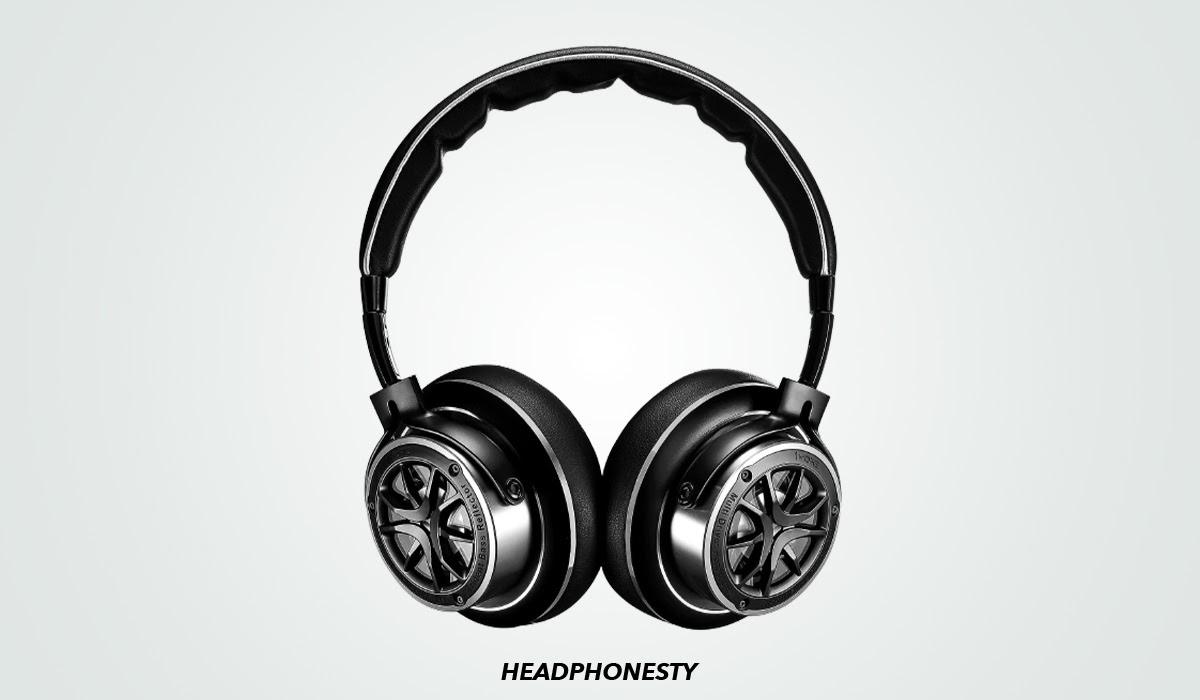
Key features
- Headphone Type: Closed-back
- Driver Type: Dynamic
- Driver Size: 40mm
- Frequency Range: 20 Hz – 40 kHz
- THD @90dB: 0.08
- Additional Bass Feature: Trident Bass Reflectors
The 1MORE H1707 come with passive bass reflectors in each ear cup for excellent bass response. They provide clean and accurate lows that don’t bleed over the mids. Overall, they have a tight, punchy sound quality that even audiophiles love, making them our best overall pick for bass headphones.
These headphones come with three drivers in each ear cup – a 40mm graphene dynamic driver, ceramic tweeter, and bass reflector. The combination of all three provides an exceptionally spacious soundstage, offering crystal clear highs and rich, extended bass. The drivers are also expertly tuned by award-winning sound engineer Luca Bignardi.
These Hi-Res certified headphones have a good frequency range of 20Hz to 40kHz. But thanks to the Trident Bass Reflector setup, they’re capable of a more extended bass response that goes down to 10Hz. And since they’re designed almost like a pair of open-back headphones with vented outer paneling, echoes in the lower frequencies won’t be an issue.
The low 0.08 THD also helps with the overal fidelity of the sound. These headphones have crystal-clear and nearly free of any distortion in all frequency range.
Build-wise, these headphones are engineered for comfort and durability. The aluminum alloy ear cups can be rotated and folded, and the stainless steel headband can be fully extended. Both are covered in soft foam and protein leather to help distribute pressure and ensure long-lasting comfort.
Skullcandy Crusher Evo
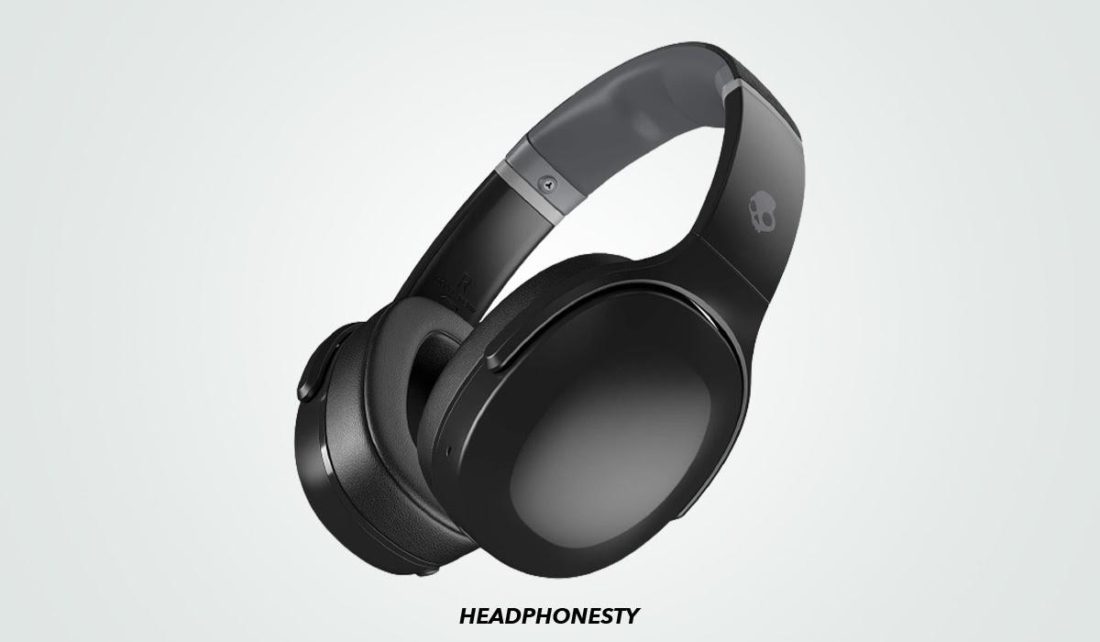
Key features
- Headphone Type: Closed-back
- Driver Type: Dynamic
- Driver Size: 40mm
- Frequency Range: 20Hz – 20kHz
- THD @90dB: 0.333
- Additional Bass Feature: Crusher Adjustable Sensory Bass slider & Personalized EQ via app
The Skullcandy Crusher Evo Sensory Bass Headphones come with a great bass response, a handy bass slider, and an EQ personalization option that allows you to customize your sound. All these features combined make these headphones the top choice for true blue bassheads.
Skullcandy’s Crusher Adjustable Sensory Bass offers the ability to boost your bass quickly and easily. By toggling the dedicated bass switch on the ear cup, you can instantly tone down or amp up your bass to bone-rattling levels. It’s a handy feature that eliminates the need to mess around with EQ settings, if that isn’t your thing.
You also get a more personalized listening experience with the Skullcandy app, which is programmed with Audiodo’s Personal Sound technology. By taking a quick hearing test, Audiodo analyzes your hearing and uses that data to optimize sound output. That way, you’re always hearing your music the way you like it.
These closed-back headphones have 40mm dynamic drivers built to deliver some pretty decent bass. But they only come with a frequency range of 20Hz – 20kHz, which is also what places them second on this list. The limited frequency range means that you might detect some distortion in the lower frequencies, especially if you have the Crusher Sensory Bass and audio volume cranked up.
In terms of comfort, the Crusher Evos have a premium and lightweight build. The ear cups are outfitted with memory foam and faux leather, which offer decent isolation. They can also swivel and fold, giving you good adjustability.
The headband is made with a combination of soft no-slip silicone and felt-like fabric material. This not only makes them comfortable for long listening sessions but also helps keep them in place.
Unfortunately, these headphones have a relatively high weighted THD of 0.33 at 90dB, compared to other pairs on this list. But despite having relatively THD, the distortions are rarely audible – even with trained ears.
Monoprice Modern Retro
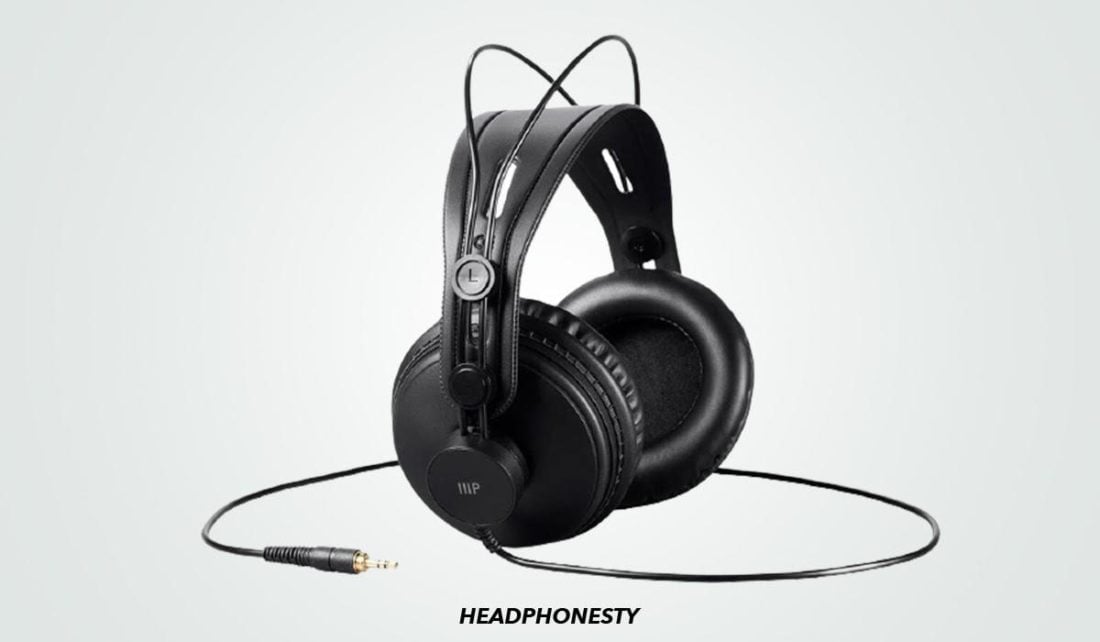
Key features
- Headphone Type: Closed-back
- Driver Type: Dynamic
- Driver Size: 50mm
- Frequency Range: 15Hz – 25kHz
- THD @90dB: 0.6
- Additional Bass Feature: N/A
The Monoprice Modern Retro headphones are highly reviewed for having a better bass response than other similarly affordable headphones. It’s also the cheapest pair on this list, costing at just below $30, making them our top budget pick for bass headphones.
These headphones are as simple and straightforward as they come. They feature a closed-back design that’s perfect for boosting those lower frequencies. They also come with dynamic 50mm drivers that deliver a robust, clean sound that’s fit for professional use.
Given their price point, they don’t come with any extra bass boosting features. However, you can still expect some top-quality listening with a good frequency response of 15Hz – 25kHz. You can also tweak your EQ settings to get that soul-crushing bass, and expect that these headphones will deliver excellent audio every single time.
The Monoprice Modern Retro headphones are also super comfortable, thanks to a lightweight build. The thin metal headband doesn’t come with any padding, but the soft, cushy ear pads are large enough to easily fit most proportions.
Unfortunately, these come with somewhat disappointing THD levels of 0.6 – which is the highest THD level from all headphones on this list. While it’s still below the 1.0 level, the distortion in this pair can still be audible at maxed volume, especially for trained ears.
Fostex TH-900 MK2
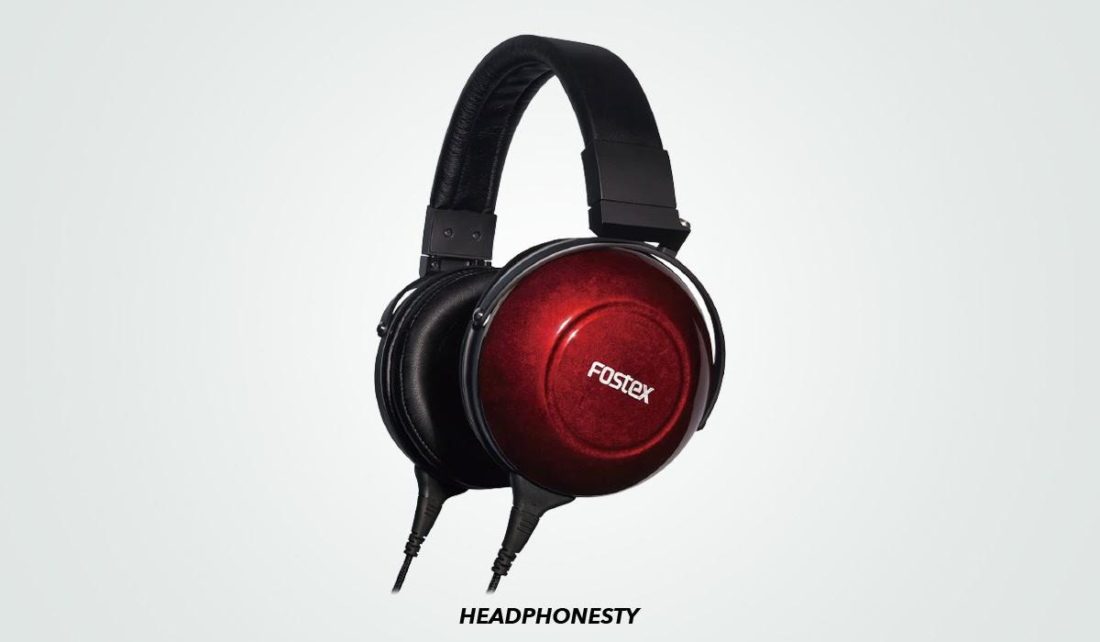
Key features
- Headphone Type: Closed-back
- Driver Type: Dynamic
- Driver Size: 50mm
- Frequency Range: 5Hz – 40kHz
- THD @90dB: 0.02
- Additional Bass Feature: N/A
The Fostex TH-900 MK2 headphones are handcrafted with premium materials and precision-tuned with exacting Japanese standards. They come well-recommended for their excellent sound quality and are quite highly priced, making them our top pick for best premium bass headphones.
These closed-back headphones are outfitted with dynamic 50mm drivers and proprietary Biodyna diaphragms, which are specially made from Bio-cellulose fiber. They’re five times more rigid and can vibrate two times faster than conventional plastic diaphragms, allowing them to deliver impeccable, high-resolution sound.
The Fostex TH-900 MK2s have a wide frequency range of 5Hz – 40kHz and offer a visceral and more immersive bass coupled with smooth mids. Their warm sound signature is largely due to wooden ear cups, expertly handcrafted from Japanese Cherry Birch. Thanks to this, the headphones can deliver amazing bass without muddying or bleeding into other frequencies.
If you want the most accurate sound reproduction, you’d be glad to hear that these headphones have 0.02 THD. This means that this pair is a contender of headphones with the lowest THD levels together with the Sennheiser HD 650 and our top pick, 1MORE H1707.
Build-wise, these cans are supremely comfortable. With these, you’ll have an adjustable headband and swiveling ear cups that come with large soft padding. This particular padding is also made from protein leather and eggshell membrane, which provides a lightweight fit.
The headphones are also both eye-catching and durable. Using a centuries-old technique, red Urushi lacquer is used to cover the outside of the ear cups. It not only gives the headphones a luxurious feel but creates a tough outer layer that repels moisture as well. The cables are sturdy, but also detachable and replaceable should any unfortunate mishaps occur.
Sony MDR-XB950B1
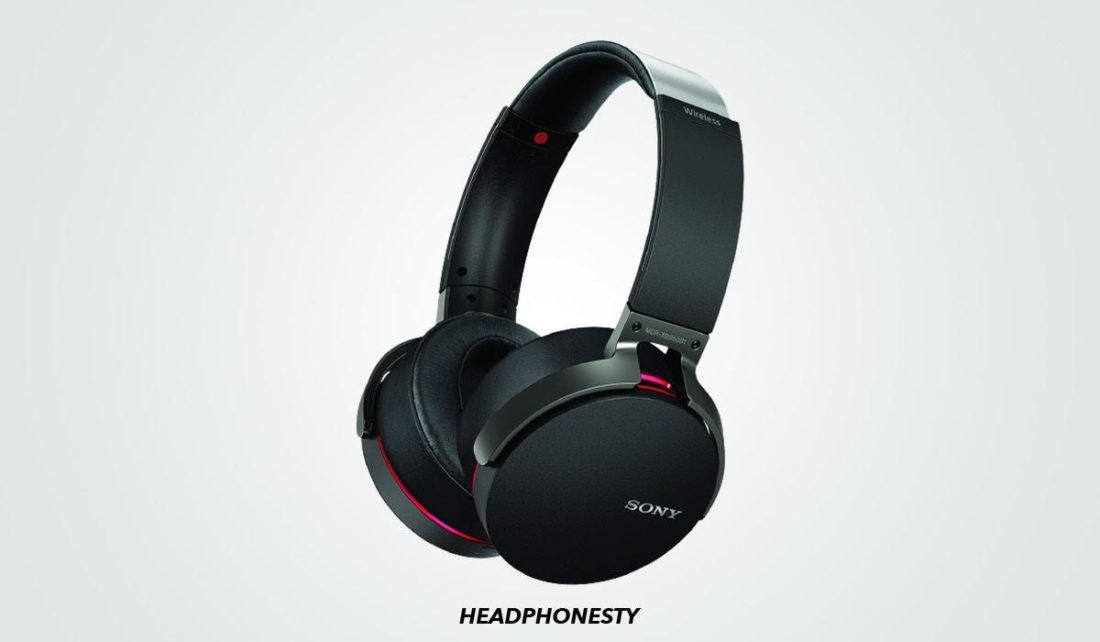
Key features
- Headphone Type: Closed-back
- Driver Type: Dynamic
- Driver Size: 40mm
- Frequency Range: 3Hz – 28KHz
- THD @90dB: 0.35
- Additional Bass Feature: EXTRA BASS™ and Sony Headphones Connect app
The Sony MDR-XB950B1 EXTRA BASS™ Wireless Headphones come with excellent bass right out of the box. But those who can’t get enough can boost it with Sony’s EXTRA BASS™ feature to punctuate those skull-shattering bass lines even further. As such, these headphones are easily our top pick for absolute bassheads.
These headphones come with solid 40mm dynamic drivers with a wide frequency range of 3Hz – 28kHz. The lower frequencies of the MDR-XB950B1 are the most expansive of all the other headphones on this list. As such, you can expect to get an excellent bass response right off the bat.
Sound accuracy and fidelity aren’t an issue with these headphones. The 0.35 weighted THD means that they can reproduce the sound signal from your audio source with high accuracy and minimum (if any) distortion.
If you find yourself still wanting more, you can simply press the Bass Effect button on the ear cup to activate Sony’s EXTRA BASS™ function. This further enhances low-end frequencies to give you that punchy, booming bass that a lot of bass heads love.
You can go even a step further with the Sony Headphones Connect app. Through the app, you can fine-tune the equalizer to get more oomph out of the bass. You can also choose from a selection of audio presets such as outdoor stage, club, hall, or arena.
Probably one of the more visually striking things about these cans (other than color) are the ear pads. They’re thick and bulky-looking, but are exceptionally comfortable and provide excellent passive noise cancellation. This in turn also helps boost bass frequencies.
Other than that, the MDR-XB950B1 comes with a sturdy steel and plastic build, with minimal padding on the headband. But that won’t be much of an issue since the headphones are quite lightweight and comfortable, even after prolonged use. Both headband and ear cups also offers a good amount of adjustability
Audeze LCD-2 Classic
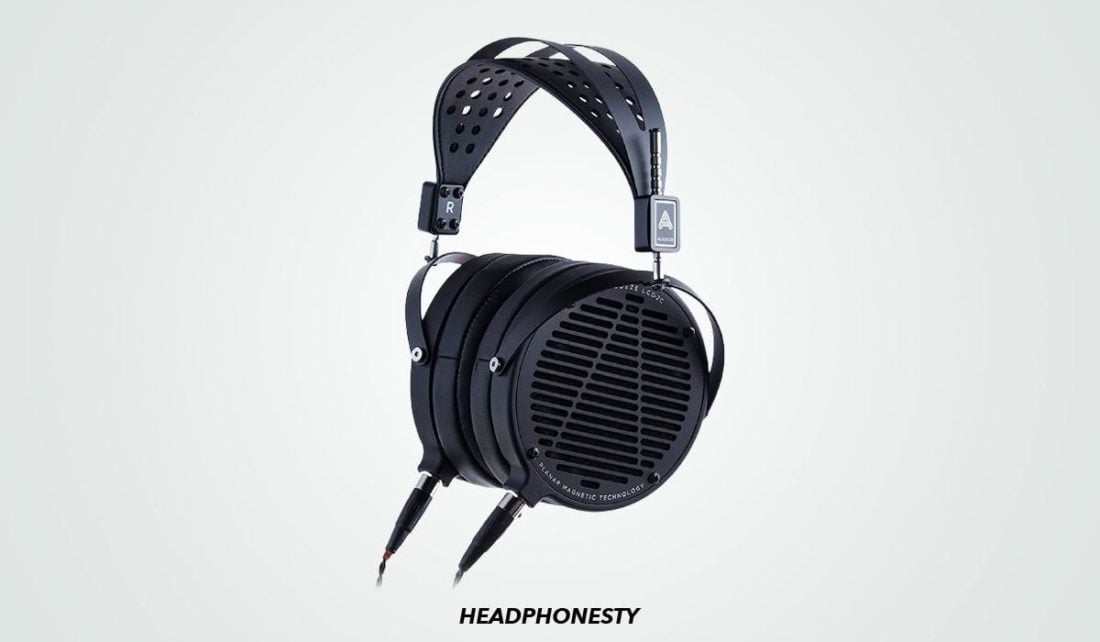
Key features
- Headphone Type: Open-back
- Driver Type: Planar magnetic
- Driver Size: 106mm
- Frequency Range: 10Hz – 50kHz
- THD @90dB: 0.28
- Additional Bass Feature: N/A
The Audeze LCD-2 Classic delivers a first-rate bass response with a tight, precise, and warm quality that’s quite exceptional for open-back headphones. They’re well-reviewed for delivering a rich and full bass quality that doesn’t sound overpowering to the ears. They also retain great detail and vibrancy in the mids and highs, making them our favorite open-back bass headphones.
These headphones are outfitted with large 106mm planar magnetic drivers, engineered to bring you clear, realistic sound that meets even the most discerning audiophile standards. At 10Hz – 50kHz, they have the widest frequency range of all the headphones on this list. This ensures not only clear highs but rich and deep lows as well.
The drivers come with ultra-thin diaphragms that are four times larger than standard diaphragms. They’re also thinner than a strand of human hair, making them literally lighter than air. This allows them to vibrate much faster to give you distortion-free, high-resolution audio, particularly in the lower frequencies.
Thanks to the low 0.28 THD, the LCD-2 Classic can achieve their distortion-free sound with minimum EQ or modification needed. While they certainly don’t have the lowest THD level in the market, they still maintain a safe level that won’t be too disruptive, even for trained ears.
In terms of fit and build, the LCD-2 Classics are surprisingly comfortable despite their bulkiness. The headband is made from black spring steel with an accompanying leather suspension head strap that does a good job of distributing pressure. The large leather ear pads are also outfitted with contoured memory foam, which provides good noise isolation and a snug fit.
SENNHEISER Momentum 3
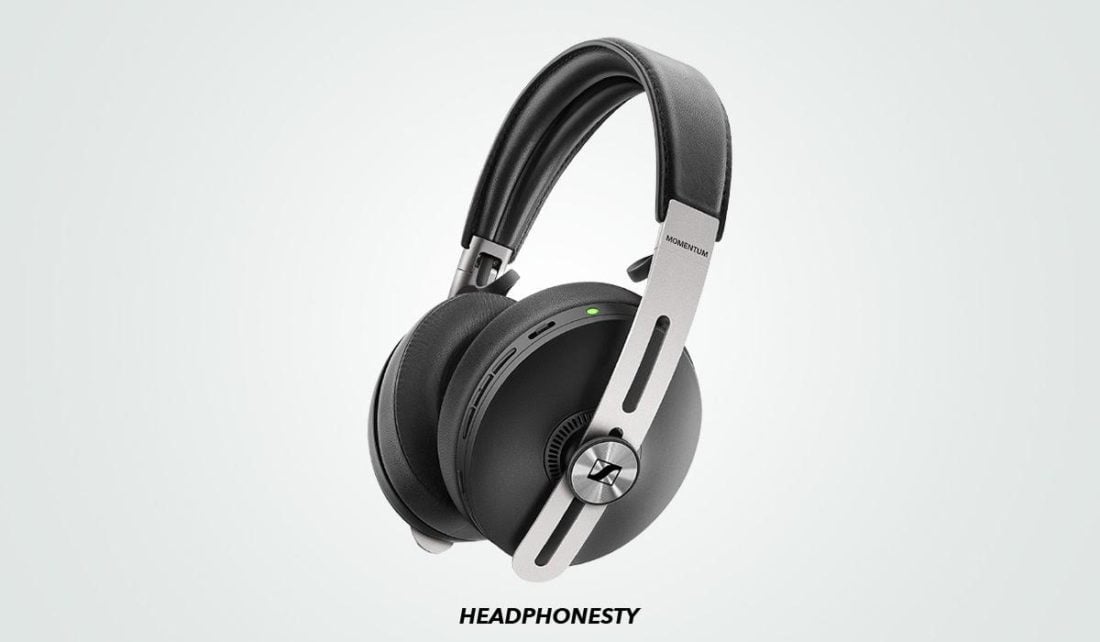
Key features
- Headphone Type: Closed-back
- Driver Type: Dynamic
- Driver Size: 42mm
- Frequency Range: 6Hz – 22kHz
- THD @90dB: 0.35
- Additional Bass Feature: Customizable EQ via the Sennheiser Smart Control app
The SENNHEISER Momentum 3 Wireless Headphones have a wide frequency range and a great bass response. They’re also most recommended for noise cancellation, making them our top pick for best noise-canceling bass headphones.
These headphones come with 42mm dynamic drivers with a good frequency range of 6Hz – 22kHz. With a balanced and extended bass response, you get bass that sounds clean and tight. This makes them particularly ideal for hard-hitting genres like EDM, Electronica, or Dubstep.
Despite not having the widest frequency range, the Momentum 3 retains a fairly low 0.35 THD that can confidently deliver high-resolution and distortion-free sound across the board.
You get three modes of active noise cancellation: Anti-Pressure, Anti-Wind, and Maximum. This feature blocks unwanted noise in any environment and enhances your listening experience. For punchier bass, you can also tweak the EQ settings on the Sennheiser Smart Control app and juice up those lower frequencies even more.
Build-wise, these cans are as comfortable as headphones can get. They have a steel and matte plastic build outfitted with genuine leather. Both the headband and ear cups have good adjustability that’ll suit any proportion. You also get quite large, oval memory foam ear pads. These feel plush and spacious when worn, ensuring long-lasting comfort.
The SENNHEISER Momentum 3 headphones are an upgraded version of the Momentum 2. While most of its main features are the same, the newer Momentum 3 comes with better sound quality and an improved design. They also come with Bluetooth 5.0 connectivity, versus Bluetooth 4.0 for the older version.
Jabra Elite Active 75t
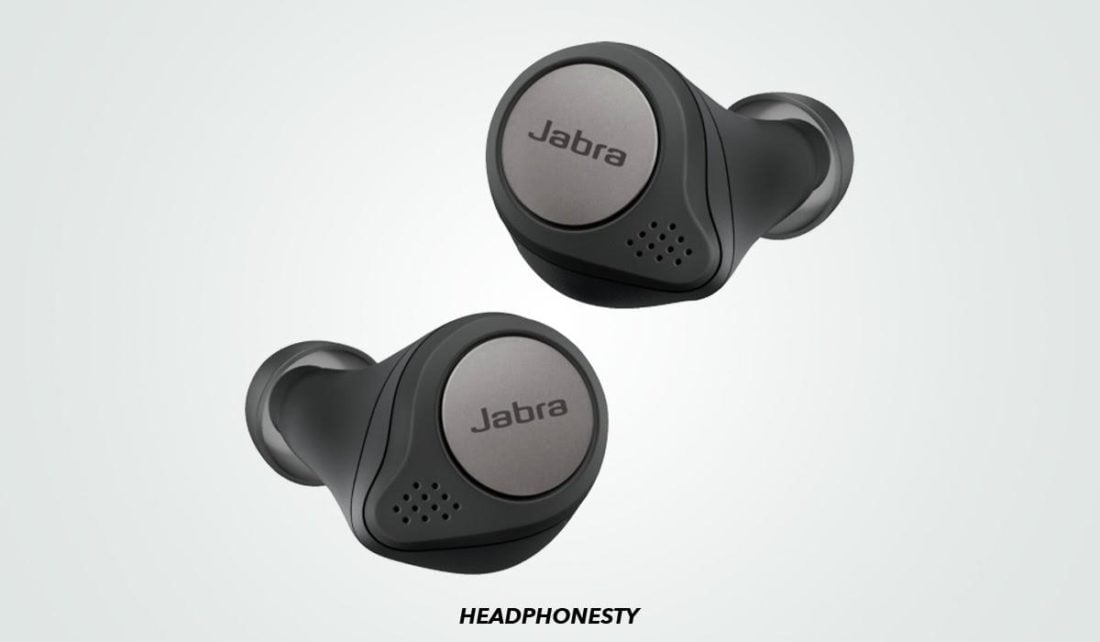
Key features
- Headphone Type: TWS
- Driver Type: Dynamic
- Driver Size: 6mm
- Frequency Range: 20Hz – 20kHz
- THD @90dB: 0.23
- Additional Bass Feature: Customizable EQ via the Jabra Sound+ app
The Jabra Elite Active 75t earbuds have some of the best reviews for bass among truly wireless earbuds. They come with a customizable EQ feature and extra audio features. As such, they’re our favorite portable bass earbuds for an on-the-go lifestyle, or for working out.
These earbuds have 6mm dynamic drivers and a standard frequency range of 20Hz – 20kHz. But despite their size, these babies can pump out some pretty powerful bass. And that’s all thanks to their noise cancellation and sound customization features.
Not only that, these earbuds can dish out clean and distortion-free sound reproduction across all frequencies thanks to their low 0.23 THD. Given how easy it is to overpower a pair of earbuds with 6mm drivers, Jabra has done a wonderful job at fine-tuning the electronics of the Active 75t.
Engineered for comfort, the 75t earbuds fit seamlessly with the help of EarGel tips. This makes them comfortable and offers good passive noise cancellation against ambient noise. Additionally, the earbuds also have an active noise cancellation feature. This further enhances your audio so that you get the most out of those rich lower frequencies.
If that isn’t enough, you can calibrate your listening experience on the Jabra Sound+ app. By taking a hearing test through MySound, you can create a personalized sound profile. You can also amp up your bass by adjusting the EQ settings on the app.
The Jabra Elite Active 75t earbuds are the successors of the older Jabra Elite Active 65t. Some improvements from the older version include a more streamlined and lightweight design. The newer earbuds also support wireless charging and have longer battery life.
